DeSci: The future revolution of scientific research, or an unattainable dream?

Reprinted from panewslab
03/03/2025·2MAuthor: @100y_eth
Compilation: Vernacular Blockchain

The academic system is full of holes, but DeSci is not a panacea.
Special thanks to @tarunchitra (Gauntlet), @NateHindman (Bio) and Benji @benjileibo (Molecule) for their feedback and review of this article.
I recently obtained Chemical Engineering Diseases and published four papers as the first author during my degree, including articles in top academic journals such as the Nature sub-job and the Journal of the American Chemical Society (JACS). Although my academic experience is limited to the postgraduate stage and I have taken the initiative to be an independent researcher, I may find out, in my nearly six years of academic career, I have deeply understood the structural problems of fire protection within the academic system.
Against this background, DeSci (Decentralized Science) hopes to use blockchain technology to challenge the centralization of traditional academic systems, which is undoubtedly an attractive concept. Recently, DeSci has set off a craze in the crypto market, and it is believed that it is expected to completely overturn the existing landscape of scientific research.
I also look forward to such a change. However, I don’t think the possibility of DeSci completely replacing the traditional academic system is high. From a realistic perspective, DeSci is more likely to serve as a supplementary force to help solve some of the core issues in the academic system.
Therefore, at the core of DeSci's bass, I hope to get the opportunity to combine my academic experience to explore some structural problems in traditional academic systems, evaluate whether blockchain technology truly provides effective solutions, and further explore the actual impact DeSci may have on the academic community.
1. The sudden DeSci craze
1) DeSci: From niche concepts to thriving movements
The long-standing structural problems in the academic community have long been widely known, such as the VOX article "Seven Scientific Problems in the Eyes of 270 Scientists" and "The War to Liberate Science" have discussed this issue in depth. Over the years, people have tried various ways to deal with these challenges, some of which we will discuss in detail later.
The concept of DeSci (Decentralized Science) is trying to solve these problems with the help of blockchain technology, but this idea didn’t gradually gain attention until around 2020. Coinbase CEO Brian Armstrong introduced the DeSci concept to the crypto community through ResearchHub and tried to re-adjust the incentive mechanism for scientific research through ResearchCoin (RSC).
However, due to the capital speculative nature of the crypto market, DeSci has
long failed to gain widespread attention, and only a few small communities are
driving their development until the emergence of pump.science. 2) Butterfly
effect caused by pump.science 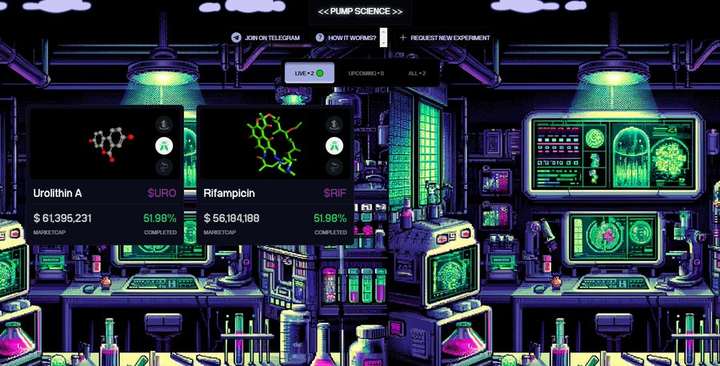
Source: pump.science
pump.science is a DeSci project in the Solana ecosystem and developed by Molecule, a well-known DeSci platform. The project is not only a fundraising platform, but also uses Wormbot technology to stream long-term experiments in real time. Users can propose compounds they believe may extend their lifespan, or purchase tokens associated with these ideas.
When the market value of a token exceeds the set threshold, the project will use Wormbot equipment to conduct experiments to verify whether the compound really has the effect of extending the life of the experiment subject. If the experiment is successful, the Token holder will obtain relevant interests in the compound.
However, some community members criticized the model, saying that these experiments lack sufficient scientific rigor and are difficult to truly promote the development of anti-aging drugs. Gwart expressed a skepticism with his ironic remarks, representing a party of DeSci's prudent and even questioning stances, questioning the arguments promoted by its supporters.
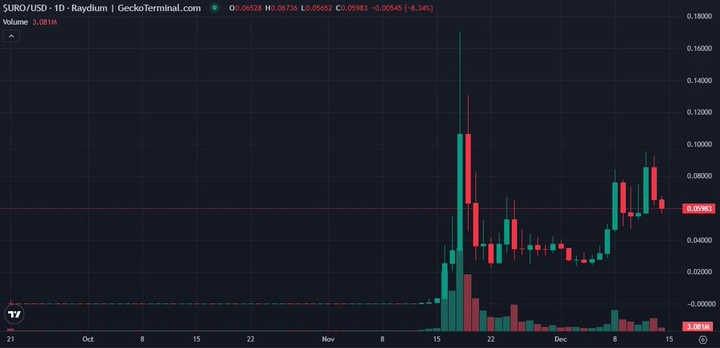
pump.science adopts the Bonding Curve mechanism, similar to Molecule's model, that is, the price of Token will continue to rise as the number of buyers increases.
Tokens launched by this project, such as RIF (corresponding to rifampin) and URO (corresponding to Urophosphate A), happened to catch up with the meme token craze in the crypto market, and prices soared. This wave of market unexpectedly pushed DeSci into the public eye. However, ironically, what really made DeSci famous was not its scientific vision, but the price surge caused by the Token speculation boom, which attracted widespread attention from the current DeSci.
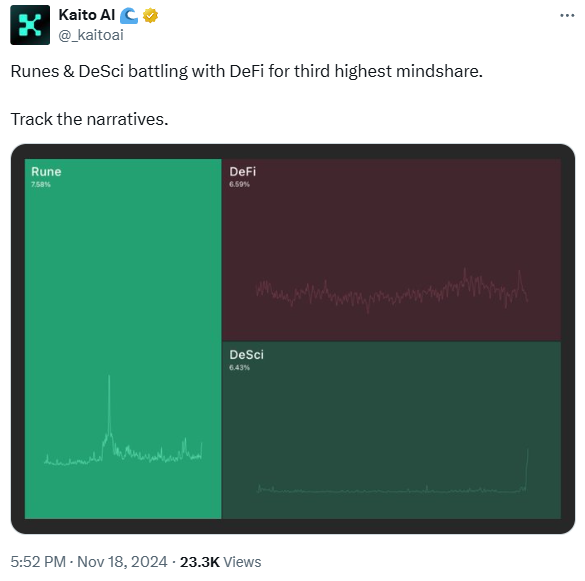
Source: @KaitoAI
In the rapidly changing crypto market, DeSci has long been a niche area. However, in November 2024, it suddenly became one of the hottest narratives. Not only did the prices of pump.sci related tokens soar, BN also announced its investment in DeSci funding agreement Bio, while other mature DeSci tokens have also experienced a sharp rise. This series of events marks a critical moment for DeSci.
2. The shortcomings of traditional science
It is no exaggeration to say that there are a lot of systematic and serious problems in the academic world. In my academic career, I often think: How does such a flawed system maintain operation? Before exploring the potential of DeSci, we might as well examine the drawbacks of traditional academic systems.
1) One of the systemic challenges: scientific research funds
A. Evolution of R&D Funding
Before the 19th century, scientists obtained research funding in a very different way than today, relying mainly on two models:
- Sponsorship: European monarchs and nobles often fund scientists to demonstrate their reputation and promote scientific progress. For example, Galileo was funded by the Medici family, allowing him to continue the research and development of telescopes and astronomy research. Religious institutions also played a role in the development of science, and in the Middle Ages, churches and clergy funded research in fields such as astronomy, mathematics and medicine.
- Self-raised funding: Many scientists rely on personal income to support research, who may be university professors, teachers, writers or engineers, earn money through these professions and maintain scientific exploration.
By the end of the 19th century to the early 20th century, a centralized scientific research funding system led by the government and enterprises began to form. Especially during World War I and World War II, governments of various countries set up scientific research institutions and invested a lot of money in national defense research to strive for victory in the war.
In the United States, the National Aviation Advisory Council (NACA) and the National Research Council (NRC) were respectively established during World War I. In Germany, the German Science Emergency Foundation (Notgemeinschaft der Deutschen Wissenschaft), the predecessor of the German Research Foundation (DFG), was born in 1920. At the same time, the rise of corporate laboratories such as Bell Labs and GE Research also marks the beginning of actively participating in scientific research funding and jointly promoting R&D development with the government.
This government- and enterprise-driven scientific research funding model has gradually become mainstream and has continued to this day. Governments and businesses invest huge budgets every year to support global researchers. For example, in 2023, the U.S. federal government spent as much as US$190 billion, an increase of 13% from 2022, highlighting the government's core role in promoting scientific research.
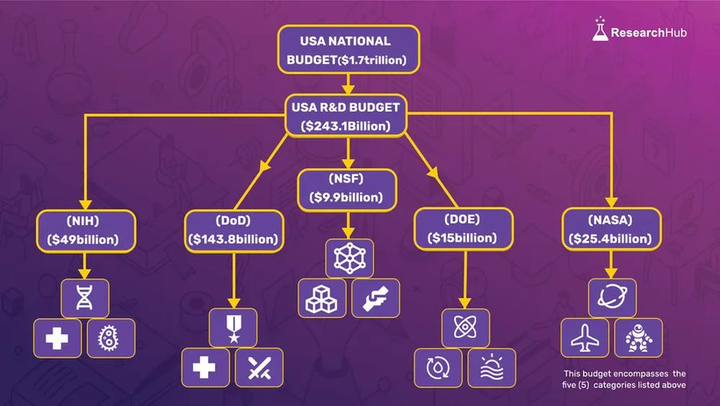
Source: ResearchHub
In the United States, the allocation process of scientific research funds is allocated by the federal government to R&D (Research and Development) by a portion of the funds from the budget and redistributed to different institutions. Among them, the main scientific research funding institutions include:
National Institutes of Health (NIH) – the world's largest funding agency for biomedical research;
Department of Defense (DoD) - Focus on defense-related research;
National Science Foundation (NSF) – Funding research in various disciplines of science and engineering;
Ministry of Energy (DOE) – Responsible for research in the fields of renewable energy and nuclear physics;
NASA - Supports aerospace and aeronautical research.
B. How centralized scientific research funding distorts science
Today, it is almost impossible for university professors to conduct research entirely independently, but must rely on external funding from governments or businesses. This highly concentrated scientific research funding system is one of the root causes of many problems in the contemporary academic community.
First of all, the application process for scientific research funds is extremely inefficient. Although the specific operations of different countries and institutions vary, overall, lengthy processes, low transparency and inefficiency are consensus in the global academic community.
If a research laboratory wants to obtain funding, it must go through a lot of tedious document preparation, repeated applications and strict reviews, which usually require layers of approval from the government or enterprise. Those top labs with high profile and rich resources may receive millions or even tens of millions of dollars in a one-time grant, so there is no need to apply for funding frequently. But this is not common.
For most laboratories, a single funding is usually only tens of thousands of dollars, and researchers have to repeatedly apply, write a large amount of documents, and continue to be reviewed.
Communication with graduate students shows that many scholars and students are unable to devote themselves to scientific research, but instead take up a lot of time by funding applications and corporate projects. What is even more helpless is that these corporate cooperation projects are often almost unrelated to students' graduation research, further exposing the inefficiency and disadvantages of the current scientific research funding system.
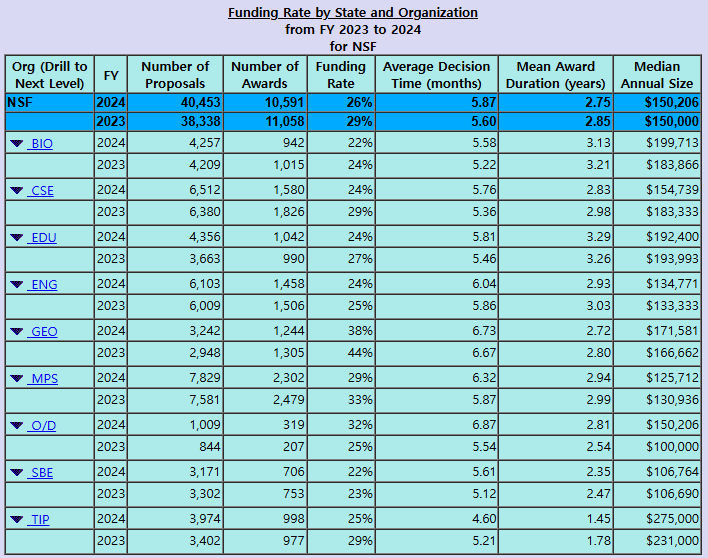
Source: NSF
Spending a lot of time applying for scientific research funds may eventually pay off, but unfortunately, getting funding is not easy.
According to the NSF (National Science Foundation), scientific research funding pass rates were 29% and 26% in 2023 and 2024, respectively, while the annual median appropriation amount for a single project was only $150,000, which is relatively limited. NIH (National Institutes of Health) funding success rates are typically between 15% and 30%. Since a single grant often struggles to meet the needs of many researchers, they have to apply for multiple projects repeatedly to maintain the research.
However, the challenge goes far beyond that. Connections play a key role in winning scientific research funds. To increase funding success rates, professors often tend to work with peers rather than apply separately. In addition, it is not uncommon for professors to lobby informally with funders in private to secure corporate funds. This dependence on connections and lack of transparency in fund allocation have made it difficult for many early career researchers to enter the academic system.
C. Another major problem with centralized scientific research funding: the lack of incentives for long-term research
Long-term scientific research funding for more than 5 years is extremely rare. According to the NSF, the funding cycle for most research funds is only 1 to 5 years, and the funding model of other government agencies is basically similar. Corporate R&D projects typically provide 1 to 3 years of research funding, depending on the business and the project itself.
Government funding is highly susceptible to political factors. For example, during the Trump administration, defense R&D funding increased significantly; while during the Democratic Party’s administration, environmental research was often the focus of funding. Long-term scientific research projects have become very rare as government policy priorities change with political agenda.
There are similar limitations in corporate funding. In 2022, the median term of office of the CEO of the S&P 500 index component company is 4.8 years, and other executives have similar terms. Because companies need to quickly adapt to industry and technological changes, and these executives often dominate the allocation of funds, scientific research projects funded by companies rarely last for a long time.
D. Short-term trends lead to a decline in scientific research quality
The centralized scientific research funding system encourages researchers to select projects that can quickly produce quantifiable results. To ensure that the funding sources are unblocked, researchers are forced to produce results within five years, which makes them more inclined to choose topics that can be completed in the short term. This trend has led to a short-term cycle in the academic community, with only a very small number of teams or institutions willing to invest more than 5 years of long-term research.
In addition, centralized funding systems have also led researchers to pay more attention to the number of papers than the quality of research, because short-term research results are often directly linked to funding assessments. Scientific research work can be roughly divided into gradual research (slight improvements to existing knowledge) and breakthrough research (opening up new fields). But the current funding model is naturally more inclined to the former. Most papers published outside top journals are often just a tiny supplement to existing research rather than disruptive innovation.
While the high degree of specialization of modern science has made breakthrough research more difficult, the centralized funding system further exacerbates this problem because it further suppresses innovative research. This model of systematic preference for gradual research has undoubtedly become another obstacle to the revolutionary breakthrough of science.
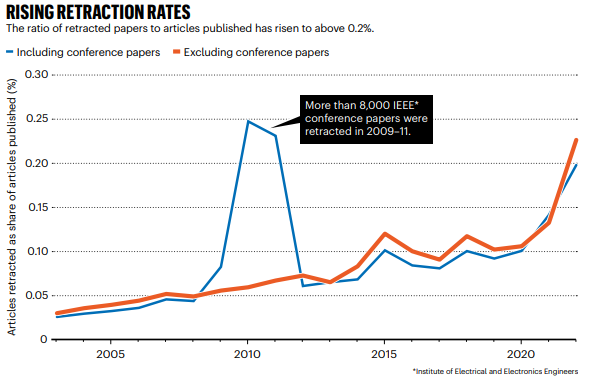
Source: Nature
Some researchers even manipulate data or exaggerate the conclusions of the study. The current scientific research funding mechanism requires researchers to deliver results in a very short period of time, which invisibly encourages academic misconduct. As a graduate student, I often hear cases of students in other labs forged data. Nature has reported that the proportion of withdrawals of academic conferences and journal papers has risen sharply in recent years, reflecting the seriousness of this problem.
E. Don’t get me wrong: centralized scientific research funding is inevitable
It should be clarified that centralized scientific research funding itself is not useless. Although this model has brought many negative effects, it remains an indispensable pillar of modern scientific development.
Unlike in the past, today's scientific research is highly complex and sophisticated. Even a project for an ordinary graduate student may cost from thousands to hundreds of thousands of dollars, not to mention large-scale scientific research projects such as defense, aerospace or basic physics, which require exponentially increasing resources.
Therefore, the centralized funding model is still necessary, but how to solve its derivative problems is the key.
2) Systematic Challenge Two: Academic Journals
A. Business operations of academic journals are in the cryptocurrency industry, and Tether, Circle (stablecoin issuer), BN and Coinbase (centralized trading platforms) are regarded as market leaders. Similarly, in academia, academic journals are the most influential centers of power, and their representatives include:
Elsevier
Springer Nature
Wiley
American Chemical Society (ACS)
IEEE (Institution of Electrical and Electronics Engineers)
Taking Elsevier as an example, the company's revenue in 2022 reached US$3.67 billion, net profit of US$2.55 billion, and its net profit margin was as high as nearly 70%, far exceeding many technology giants. For example, NVIDIA's net profit margin is about 55-57% in 2024, while academic publishers have even higher margins.
Springer Nature's revenue in the first nine months of 2024 has reached US$1.44 billion, which shows how large the academic publishing industry is.
The main sources of income for academic journals include:
Subscription Fee: Access to papers in journals usually requires subscription, or pay for access to a single article.
Paper Processing Fee (APC): Many papers are within a paywall, but authors can choose to pay for publication to make their papers open access.
Copyright License and Paper Reprinting: In most cases, once a paper is published, the author must transfer the copyright to the journal. Journal publishers make profits by selling licenses to educational institutions or commercial companies.
B. Journal: The core of the mismatch of interests in academia
At this point, you might ask: "Why can journals dominate the entire academic community? Isn't their business model just like publishers in other industries?"
The answer is no. The business model of academic journals is a typical case of misaligned incentives in the academic world.
In the traditional publishing industry or online platforms, publishers often want to make creators’ work reach a wider audience and share the benefits with creators. However, the model of academic journals is entirely inclined toward the publisher itself and has little practical benefits for researchers and readers.
Although journals play an important role in disseminating scientific research results, their profit model is mainly to profit publishers, while the interests of researchers and readers are severely weakened.
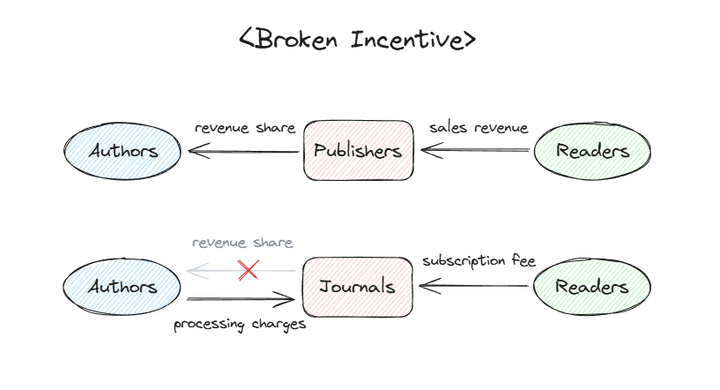
If a reader wants to read an article in a journal, he or she must pay a subscription fee or a single article purchase fee. But if researchers want to publish papers in Open Access, they will need to pay high paper processing fees (APC) to the journal and will not receive any profit share.
What’s even more unfair is that researchers not only do not have the right to share the benefits after publication, but in most cases, once a paper is published, the copyright is automatically transferred to the journal, which means that the journal can make a profit through the content of the paper completely autonomously. This system is highly exploitative for researchers and is fundamentally extremely unfair to researchers.
The business model of academic journals not only has serious exploitation problems, but its profit scale is even more amazing. Take Nature Communications (one of the most well-known fully open access journals in the field of natural sciences) as an example. For every paper published, the author pays up to $6,790 in paper processing fees (APC). In other words, researchers have to pay for their own money to publish papers in Nature Communications, a charging standard that is sky-high.
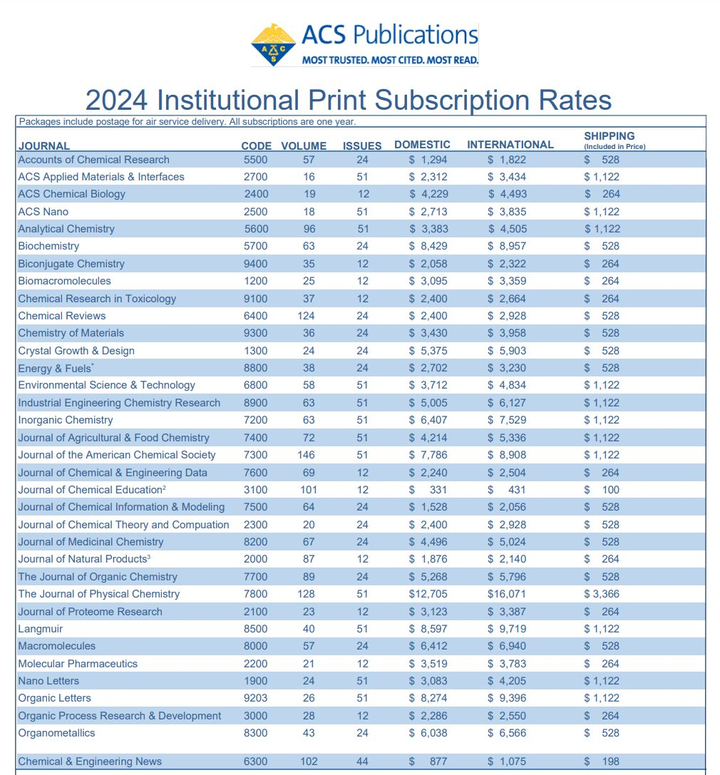
Source: ACS
Subscription fees for academic journals are equally astonishingly high. Although institutional subscription fees vary according to the field and type of research of the journal, the average annual fee for single-book journals under the American Chemical Society (ACS) is as high as $4,908. If an institution subscribes to all ACS journals, the annual cost will be as high as $170,000.
The average annual fee for a single book for Springer Nature journals is about $10,000, and the full subscription fee is about $630,000. Since most research institutions usually subscribe to multiple journals, this makes the access cost of researchers extremely high.
C. The biggest problem: researchers are forced to rely on journals, and funds come mainly from governments and businesses
What is even more worrying is that researchers are almost "kidnapping" within the academic journal system because they must rely on journals to publish papers to accumulate academic qualifications, and most of the funds in this system actually come from scientific research funds from governments or enterprises.
Specifically, the exploitation model of academic journals operates as follows:
Researchers need to continuously publish papers to accumulate academic achievements in order to obtain more scientific research funds and promote career development.
The research funding for the paper comes mainly from government or enterprise scientific research funding, rather than from researchers’ own pockets.
The publication fee for open access papers (APC) is also paid by scientific research funds, not individually responsible for the researchers.
Most of the journal subscription fees paid by scientific research institutions come from scientific research funds provided by the government or enterprises.
Since researchers use external funds most of the time, rather than at their own expense, they often do not conflict with these high costs. It is precisely because academic journals have taken advantage of this to form a highly exploitative business model of "charging both authors and readers, and monopolizing the copyright of the paper."
D. Poorly designed peer review process
The problem with academic journals is not just their profit model, but the inefficiency and lack of transparency in their publishing process are also worthy of attention. In my six-year academic career, I have published four papers and encountered many problems, especially the inefficient contribution process and a highly reliant peer review system.
The standard peer review process for most journals usually includes the following steps:
Researchers organize research results, write papers, and submit them to target journals.
Journal editors evaluate whether the paper meets the journal scope and basic standards. If appropriate, the editor will assign 2-3 peer reviewers to review the paper.
Peer reviewers evaluate papers, provide comments and problem feedback, and make one of the following four decisions:
Accept: The paper can be published directly without modification.
Minor Revisions: The paper has basically been approved, but it needs to be slightly revised.
Major Revisions: The paper needs to be majorly revised, and then decide whether to accept it after it is revised.
Reject: The paper is rejected directly and will not be published.
Researchers modify the paper based on reviewers’ opinions and the editor makes the final decision.
Although this process may seem reasonable, it is actually full of inefficiency, inconsistency, and highly relied on subjective judgments, which may undermine the quality and fairness of the review system.
Question 1: The review efficiency is extremely low. Although the review time of different disciplines may vary, in the fields of natural science and engineering, the approximate time from the submission of the paper to the final decision is as follows:
Desk Reject time: 1 week - 2 months
Time of feedback received by peer review: 3 weeks - 4 months
Time of final decision received: 3 months - 1 year
If there is a delay in the journal or reviewer, or if the paper requires multiple rounds of review, the entire publication cycle may exceed one year.
For example, in my case, the editor sent my paper to 3 peer reviewers, but one of them did not respond, causing the journal to have to look for new reviewers, adding 4 additional months of review time.
Worse, if the paper is still rejected after a long period of review, the researchers must re-submit it to another journal, which means the entire process needs to be restarted and at least doubled.
Such an inefficient publication process is extremely unfavorable for researchers, because while waiting for publication, other teams may have published similar studies, resulting in the loss of novelty of the paper, which in turn has a serious impact on the researchers' career. Question 2: The shortage of reviewers leads to high randomness in review results. As mentioned earlier, each paper is usually reviewed by 2-3 reviewers, and whether the paper is finally accepted often depends on the opinions of these few people.
Although reviewers are usually experts in the field, the review results still have a certain component of luck.
Let me give you my personal experience:
I once contributed to a top journal A and received two major revisions and one minor revisions, but the paper was rejected in the end.
I then contributed to the second-level journal B, but the result was even worse - one reviewer rejected the manuscript directly and another submitted major revisions.
Ironically, Journal B’s academic influence is actually lower than Journal A, but the review opinions are stricter.
This reveals a problem: paper review relies heavily on the subjective opinions of a few reviewers, while journal editors have complete reviewer choice.
In other words, whether the paper can pass depends to some extent on "luck":
If the reviewer is more tolerant, the paper may be passed smoothly;
If the reviewer is more demanding, the paper may be rejected directly.
In extreme cases, the same paper may be accepted if reviewed by three loose reviewers, but may be rejected if reviewed by three strict reviewers.
Increasing the number of reviewers to improve review fairness is not realistic, as more reviewers means higher communication costs and longer review time, which is contrary to the journal's operating goals.
Question 3: The lack of incentives for peer reviews has led to low review quality. The lack of incentive mechanisms during peer reviews has led to uneven quality of review opinions. The specific situation varies from reviewer to reviewer - some reviewers have a deep understanding of the content of the paper and provide valuable comments and questions; while others have not read the paper carefully, raised questions that have been answered in the paper, and even gave insignificant criticisms, which may eventually lead to the paper being asked to be overhauled or rejected directly.
This is quite common, and many researchers have experienced it, eventually making them feel that their efforts are being denied for no reason.
The fundamental reason for this problem is that peer review does not have any substantial incentive mechanisms, making quality control extremely difficult.
Currently, after receiving submissions from a paper, journals usually invite university professors or researchers in related fields to review the manuscript. However, even if these reviewers invest their time reading, analyzing and writing reviews, they will not receive any reward for this.
From a professor or graduate student perspective, peer review is just an extra gratuitous burden, and the lack of incentives has made many reviewers perfunctorily and even unwilling to devote their energy to reviewing carefully. Question 4: The lack of transparency in peer review can easily lead to bias. Peer review adopts anonymity mechanism to ensure fairness, but the problem is that reviewers can see the information of the author of the paper, but the author cannot know the identity of the reviewer.
This information asymmetry can lead to review bias, such as:
"Personal Review" - If the author is an acquaintance or academic partner of the reviewer, he may give a relaxed review opinion, and may be accepted even if the paper is of average quality.
"Malicious suppression" - If the author of the paper comes from a competitive team, the reviewer may deliberately give negative comments, or even delay the review time, causing competitors to miss the opportunity to publish the paper.
This kind of "blind-box operation" in the academic world is far more common than people think.
E. Illusion of influence factors
The last core issue of the journal system is the number of citations (Citation Count).
So, how to evaluate a researcher’s academic achievement and professional ability? Each researcher has different advantages:
Some are good at experimental design.
Some are good at discovering potential research directions.
There are also some that can dig deep into neglected details.
However, it is almost impossible to fully evaluate every researcher through a qualitative approach. Therefore, the academic community generally relies on quantitative indicators to measure the academic influence of researchers with a simple numerical value, which is mainly reflected in the number of citations (Citation Count) and the H-index (H-index).
In academia, researchers with higher H index and paper citations are often considered more successful.
The H-index is an indicator that measures the academic output and influence of researchers. For example:
If a researcher has an H index of 10, it means that he has at least 10 papers, each paper has been cited at least 10 times.
Although the H index is a common indicator of research influence, ultimately, the number of citations remains the most important criterion for evaluation.
So, how can researchers increase the number of citations in papers?
In addition to publishing high-quality papers, choosing the right research direction is also crucial. The popularity of the research field and the number of researchers will affect the number of citations of papers - the more researchers, the greater the possibility of citing papers, and naturally the number of citations will be higher.
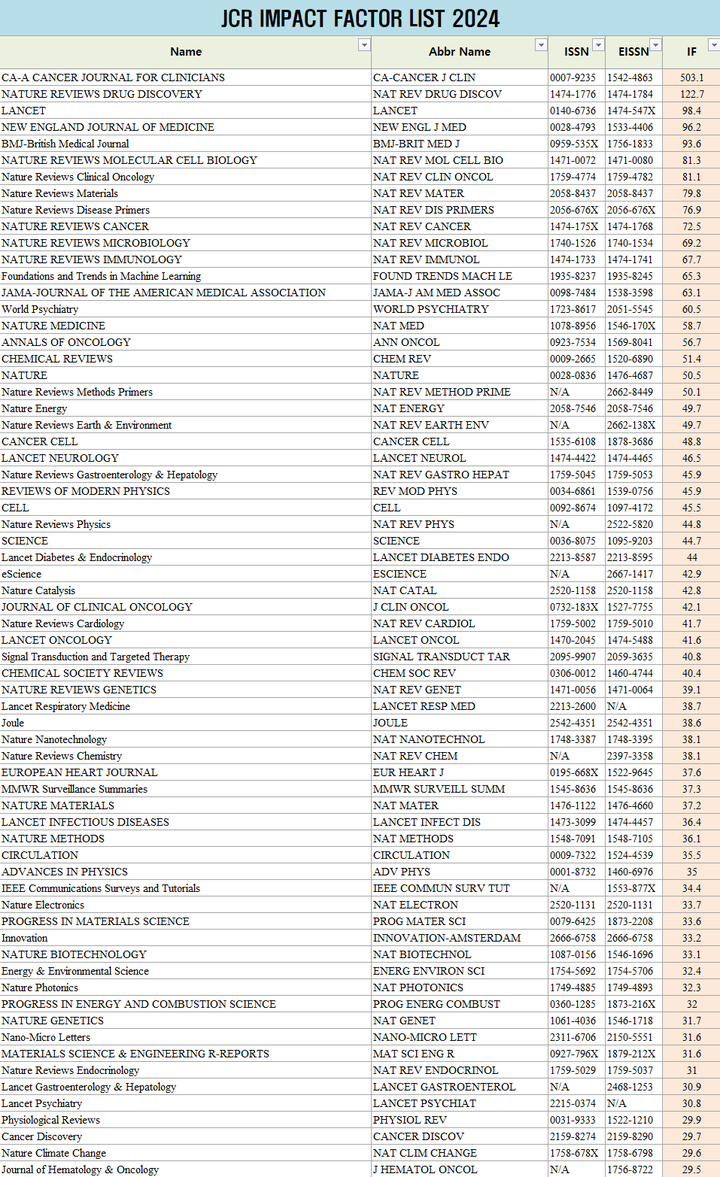
Source: Clarivate
The above table shows the Journal Impact Factor (IF) ranking published by Clarivate. The impact factor (IF) represents the average annual citation number of papers in a journal. For example, if the impact factor of a journal is 10, the papers published in that journal will be cited 10 times per year on average.
After observing the ranking, it can be found that journals with high impact factors are mainly concentrated in certain specific research fields, such as cancer, medicine, materials, energy, machine learning, etc. Even in a wider range of disciplines, such as chemistry, batteries and environmentally friendly energy, the citation rate is generally higher than that of traditional organic chemistry.
This suggests that the academic community’s over-reliance on the number of citations as the primary evaluation criteria may lead researchers to concentrate on specific popular areas, thus affecting the diversity of research.
In addition, this also reflects that the number of citations and impact factors are not common criteria for measuring the quality of researchers or journals. For example, in journals under the same ACS (American Chemical Society):
ACS Energy Letters has an impact factor of 19, while JACS (Journal of the American Chemical Society) has an impact factor of only 14.4, but JACS has long been considered one of the most authoritative journals in the field of chemistry.
Nature is generally considered one of the most ideal journals for researchers, however, due to its wide range of research areas, its impact factor is 50.5. In contrast, its sub-built Nature Medicine focuses on the field of medicine, but its impact factor is as high as 58.7.
F. Publish or Perish
Success comes from failure. Progress in any field requires failure as a stepping stone. The research results published in the academic community today are usually the accumulation of countless experiments and failed attempts.
However, in modern scientific research, almost all papers report only the results of "successful" experiments, and those failed attempts to succeed are often not published or even directly ignored.
In a competitive academic environment, researchers have little incentive to report failed experiments because it does not help their career development and may even be considered a waste of time.
3) The third systemic challenge: cooperation (collaboration)
In the field of computer software, Open-Source Projects has completely changed the software development model, making code publicly accessible, and encouraged developers around the world to contribute together, thus enabling more efficient collaboration and better software products.
However, the development trajectory of the scientific community is exactly the opposite.

Letter from Isaac Newton to Robert Hooker
In early scientific development periods such as the 17th century, scientists based on natural philosophy, prioritized sharing of knowledge, showed an open and cooperative attitude, and actively kept a distance from the rigid authoritative system. For example, despite academic competition between Isaac Newton and Robert Hooke, they still exchanged each other's research results through letters, criticized and corrected each other, and jointly promoted scientific progress.
In contrast, the research environment of modern science is more closed. Researchers must seek scientific research funding in fierce competition and strive to publish papers in high-impact factor journals. Unpublished studies are usually strictly confidential and external sharing is strongly restricted. Therefore, laboratories in the same research field often regard each other as competitors and lack channels to understand each other's research progress.
Since most of the research is gradually promoted based on previous research, it is very likely that different laboratories will study the same topic within a similar time. But in the absence of a shared research process, the same research tends to be unfolded in parallel in multiple laboratories. This is not only extremely inefficient, but also creates an academic environment of "winner-takes-all" -- the first lab to publish its research results will receive all academic recognition.
What researchers often encounter is that when they are about to complete the research, they find that other labs have pre-selled to publish similar studies, resulting in a lot of their efforts becoming worthless.
In the worst case, even researchers in the same laboratory may conceal experimental data or research results from each other, forming internal competition rather than collaborative win-win results.
Today, Open Source has become the cornerstone of the field of computer science. The modern scientific community also needs to turn to a more open and cooperative culture to promote the broader public interest.
3. How to repair traditional science (TradSci)?
1) Many people have tried to improve
Researchers in the scientific community are well aware of the problems existing in the current system. However, although these problems are obvious, they are often deeply rooted structural problems that cannot be easily solved by individuals. Nevertheless, many attempts have been put into practice over the years in an attempt to improve the status quo.
A. Restoration of centralized scientific research funding
Fast Grants: During the COVID-19 pandemic, Stripe CEO Patrick Collison found the traditional research grant process inefficient and launched the Fast Grants program to raise $50 million to fund hundreds of research projects. The program determined the funding decision within 14 days, with funding ranging from $10,000 to $500,000, providing relatively considerable support to researchers.
Renaissance Philanthropy: Founded by Tom Kalil, who served as a science and technology policy consultant in the Clinton and Obama administrations. This is a nonprofit consulting agency that focuses on connecting funders with high impact science and technology projects. Funded by Eric and Wendy Schmidt, the organization has a model similar to the Patronage System that European scientists once relied on.
HHMI (Howard Hughes Medical Institute): Unlike traditional project funding models, HHMI adopts a unique funding model that directly supports individual researchers rather than specific scientific research projects. This long-term funding model reduces the pressure on researchers on short-term outcomes, allowing them to focus on ongoing scientific exploration.
experiment.com: This is an online crowdfunding platform that allows researchers to introduce their research to the public and raise necessary funds from individual donors, providing a new model of decentralized research funding.
B. Improve academic journals
PLOS ONE: PLOS ONE is an Open Access scientific journal that allows anyone to read, download and share papers for free. It evaluates papers based on scientific validity rather than impact, and accepts negative, invalid or unconcluded research results, and enjoys a high reputation in the academic world. In addition, its simplified publishing process allows researchers to disseminate research results faster. However, PLOS ONE charges researchers $1,000–5,000 in article processing fees (APCs), which remains a big threshold.
arXiv, bioRxiv, medRxiv, PsyArXiv, SocArXiv: These preprint servers allow researchers to share draft papers before formal publication, thereby quickly disseminating research results, declaring research priorities, and providing opportunities for community feedback and cooperation. At the same time, they are open to readers for free, greatly reducing the threshold for academic access.
Sci-Hub: Founded by Kazakh programmer Alexandra Asanovna Elbakyan, Sci-Hub aims to bypass the journal paywall and provide free access to papers. Although the site is illegal in most jurisdictions and has been legally litigated by publishers such as Elsevier, it has been praised for promoting open access to academics and has also been controversial for violating the law.
C. Improve academic cooperation
ResearchGate: A professional social platform for researchers, providing paper sharing, academic question-and-answer, research cooperation opportunities, and promote global academic exchanges.
CERN (Centre for Nuclear Research): As a nonprofit organization for particle physics research, CERN organizes many large experiments that are difficult to complete in a single laboratory. It brings together researchers from multiple countries and contributes funds based on the GDP of participating countries to form an international and collaborative scientific research model.
2) DeSci: A new wave of change
Although the aforementioned attempts have made some progress in improving modern scientific challenges, they have failed to bring about a disruptive impact that is sufficient to revolutionize the academic system.
In recent years, with the rise of blockchain technology, a new concept called Decentralized Science (DeSci) has begun to attract attention and is seen as a potential solution to these structural problems.
But what exactly is DeSci? Can it really completely reshape the modern scientific system?
4. DeSci appears
1) DeSci Overview
DeSci (Decentralized Science) aims to turn scientific knowledge into a public resource and build a more efficient, fair, transparent and open scientific system by improving scientific research funding, research processes, peer review and research results sharing mechanisms.
Blockchain technology plays a central role in achieving this goal, and its main features include:
Transparency: Except for the privacy chain, blockchain is essentially open and transparent, and anyone can view on-chain transactions. This feature can enhance the transparency of scientific research funding, peer review and other processes, and reduce undercover operations and unfairness.
Ownership: Blockchain assets are protected by private keys, allowing researchers to easily claim ownership of data, thereby monetizing research results, or confirming the intellectual property (IP) that fund research.
Incentive Scheme: Incentive Scheme is the core of blockchain network. Through Token incentives, DeSci can encourage scientific researchers to participate more actively in research, review and data sharing, and increase their willingness to cooperate.
Smart Contracts: Smart contracts run on a decentralized network and can automatically perform predetermined operations according to code settings. This feature can transparently and impartially manage scientific research cooperation and automatically execute interactive logic such as scientific research funding, data sharing and research incentives.
2) Potential applications of DeSci
As the name suggests, DeSci can be applied to multiple fields of scientific research. ResearchHub divides the potential applications of DeSci into the following five major directions:
Research DAOs: These decentralized autonomous organizations (DAOs) focus on specific research topics and use blockchain technology to transparently manage research planning, funding allocation, governance voting and project operations.
Publishing: Blockchain can decentralize the academic publishing system and completely change the traditional publishing model. Research papers, data and code can be permanently stored on the blockchain, ensuring data credibility, achieving free access for everyone, and incentivizing peer reviews through tokens to improve review quality and transparency.
Research Funding & Intellectual Property (Funding & IP): Researchers can easily raise research funds from the world through blockchain networks. In addition, research projects can use tokenization to allow token holders to participate in research direction decisions and even share future intellectual property (IP) benefits.
Data: Blockchain provides a secure and transparent storage and management mechanism, supports the sharing and verification of research data, and reduces academic fraud and data tampering.
Infrastructure: Including governance tools, storage solutions, community platforms and identity authentication systems, these can be directly integrated into the DeSci project to support the development of the decentralized scientific research ecosystem.
The best way to truly understand DeSci is to delve into specific projects in the DeSci ecology and see how they solve structural problems in modern scientific systems. Next, we will focus on representative projects in the DeSci ecosystem.
5. DeSci Ecosystem
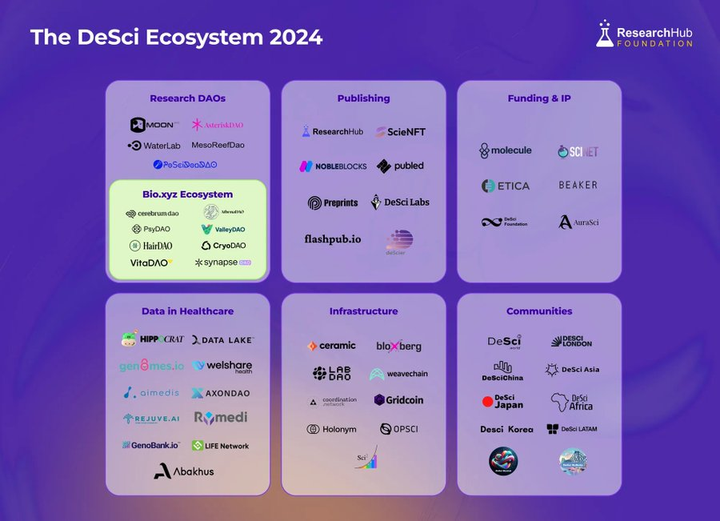
Source: ResearchHub
1) Why the Ethereum ecosystem is most suitable for DeSci
Unlike DeFi, gaming, artificial intelligence (AI), DeSci projects are mainly concentrated in the Ethereum ecosystem. The main reasons for this trend include:
Credible Neutrality: Among all smart contract platforms, Ethereum is the most neutral network. The DeSci area involves a large amount of capital flows (such as scientific research funding), so decentralization, equity, censorship resistance and credibility are crucial. This makes Ethereum the optimal network for building DeSci projects.
Network Effect: Ethereum is the smart contract network with the largest user scale and liquidity. Compared with other fields, DeSci is still a relatively niche track. If the project is distributed on multiple different public chains, it may lead to liquidity and ecological fragmentation, thereby hindering the development of the project. Therefore, most DeSci projects choose to be built on Ethereum to take advantage of its powerful network effects.
DeSci Infrastructure: Few DeSci projects are built entirely from scratch, and most of them will use existing DeSci infrastructure (such as Molecule) to accelerate development. Since most of the DeSci infrastructure tools are currently based on Ethereum, the projects in this ecosystem are naturally dominated by Ethereum.
For these reasons, the DeSci project introduced in this discussion mainly belongs to the Ethereum ecosystem. Next, we will explore representative projects in the DeSci field in depth.
2) Research funding and intellectual property rights (Funding & IP)
A. Molecule 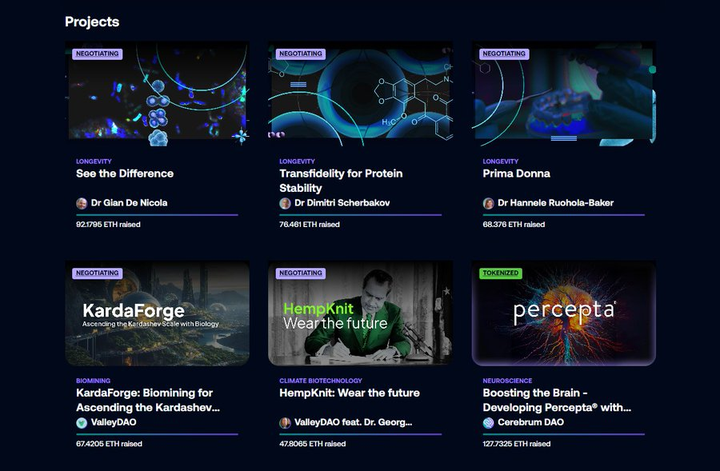
Source: Molecule
Molecule is a biopharmaceutical intellectual property (IP) funding and tokenization platform. Researchers can raise funds from many individuals through blockchain to tokenize the intellectual property of the research project, while funders can obtain IP Tokens (IP Tokens) based on their contribution ratio.
Catalyst is a decentralized research funding platform launched by Molecule to connect researchers and funders.
Researchers need to prepare relevant documents and project plans and submit research proposals on the Catalyst platform.
Funders can view proposals, select supported projects, and use ETH to provide funding.
When the project is completed, the platform will issue IP-NFT (intellectual property NFT) and IP Tokens, and funders can claim the corresponding IP Tokens based on their investment ratio.
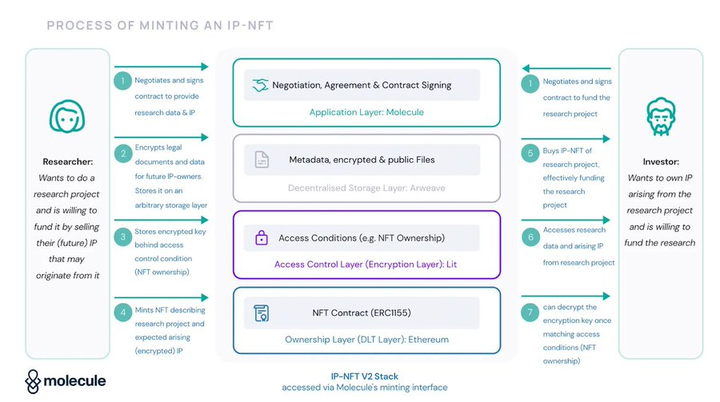
Source: Molecule
IP-NFT is a tokenized version of the on-chain intellectual property (IP) of research projects, which integrates two legal agreements into smart contracts.
The first legal agreement is a Research Agreement, signed by researchers and funders. The content of the agreement includes key terms such as the scope of research, delivery results, timetable, budget, confidentiality terms, intellectual property and data ownership, paper publication, research results disclosure, authorization and patent conditions.
The second legal agreement is an Assignment Agreement, which ensures that the rights of the research agreement can be transferred with the change of ownership of the IP-NFT, that is, the rights of the current IP-NFT holder can be transferred to the new owner.
IP Tokens (IP Tokens) represents part of the governance rights of the intellectual property rights of the research project.
Token holders can participate in key research decisions and obtain exclusive research information.
IP Token itself does not directly guarantee the distribution of profits of research results, but future commercial profits may be determined by IP holders whether to be distributed to IP Token holders.
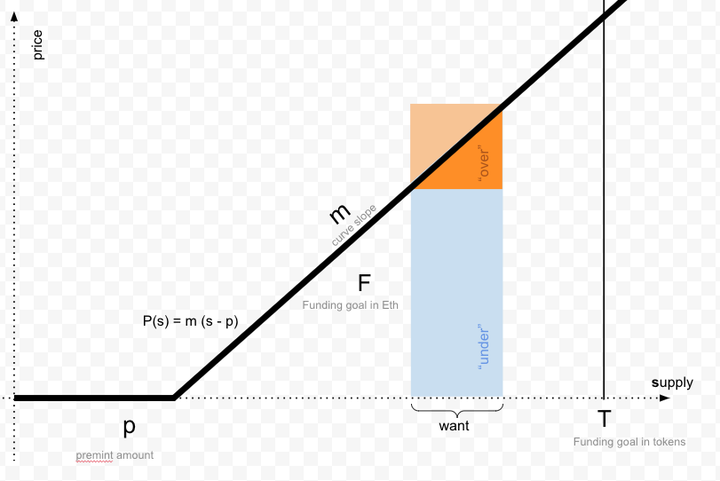
Source: Molecule
The price of IP Tokens is determined by Catalyst Bonding Curve, which reflects the relationship between the supply of tokens and the price. With the issuance of more tokens, the price of tokens will gradually rise. This mechanism incentivizes early funders to enable them to obtain IP tokens at a lower cost, thereby enhancing the attractiveness of scientific research funding.
Here are some examples of successful scientific research funding through Molecule:
Fang Laboratory at the University of Oslo: Fang Laboratory focuses on aging and Alzheimer's research, and is funded by VitaDAO through Molecule's IP-NFT framework to identify and characterize new drug candidates activated by mitophagy, which is of great significance to Alzheimer's research.
Artan Bio:Artan Bio 专注于tRNA 相关研究,并通过Molecule 的IP-NFT 框架,从VitaDAO 社区获得91,300 美元的科研资助。
B. Bio.xyz 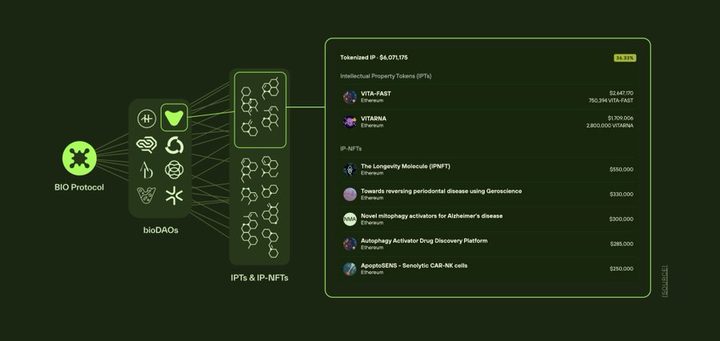
来源:Bio.xyz
Bio.xyz 是一个DeSci 领域的策划与流动性协议,类似于支持BioDAOs 的孵化器。其目标包括:
策划、创建并加速新BioDAOs 在链上资助科研。
Provides long-term funding and liquidity for BioDAOs and on-chain biotech assets.
标准化BioDAO 的框架、Token经济模型和数据/产品体系。
Promote the generation and commercialization of scientific intellectual property rights (IP) and research data.
BIO Token持有者可以投票决定哪些新的BioDAOs 加入生态系统。当BioDAO 获批加入BIO 生态后,投票支持该BioDAO 的BIO Token持有者可参与其初始筹得Token拍卖,类似于白名单种子轮融资。
获批的BioDAO 治理Token(如VITA)将与BIO Token 进行配对并添加至流动性池,从而解决BioDAOs 在治理Token上的流动性问题(例如VITA/BIO 交易对)。此外,Bio.xyz 运行bio/acc 奖励计划,为完成关键里程碑的BioDAOs 提供BIO Token奖励。
此外,BIO Token是多个BioDAOs 的元治理Token(Meta-Governance Token),BIO 持有者可以参与多个BioDAO 的治理。同时,Bio.xyz 向孵化中的BioDAOs 提供10 万美元资助,并获取其6.9% 的Token供应,以增加协议管理的资产规模(AUM),提升BIO Token的价值。
Bio.xyz 采用Molecule 的IP-NFT 和IP Token(IP Tokens)框架进行知识产权管理。例如,VitaDAO 已成功在Bio 生态内发行IP Token(如VitaRNA 和VITA-FAST)。
目前,Bio.xyz 正在孵化的研究型DAO 包括:
Cerebrum DAO:专注于预防神经退行性疾病。
PsyDAO: Committed to promoting the evolution of consciousness through safe and accessible hallucination experiences.
cryoDAO: Promoting Cryopreservation Research.
AthenaDAO: Advancing women's health research.
ValleyDAO: Supports Synthetic Biology research.
HairDAO: Cooperate to develop hair loss treatment programs.
VitaDAO: Focus on human lifespan extension (Longevity) research.
C. 总结Bio.xyz 负责策划BioDAOs,并提供Token经济框架、流动性服务、科研资助及孵化支持。当Bio 生态内的BioDAOs 知识产权(IP)成功商业化时,Bio.xyz 的资金库价值随之增长,形成良性循环。
3)研究型DAO(Research DAOs)
A. VitaDAO
在众多研究型DAO 中,VitaDAO 无疑是最知名的之一。它之所以广受关注,是因为它不仅是DeSci 领域的早期项目,还曾在2023 年获得辉瑞风投(Pfizer Ventures) 的领投。
VitaDAO 专注于寿命延长(Longevity)和衰老研究,至今已资助超过24 个项目,提供资金超420 万美元。作为回报,VitaDAO 通过Molecule.xyz 的IP-NFT 框架获得IP-NFT 或相关公司的股权。
VitaDAO 充分利用区块链的透明性,其资金库(Treasury)对外公开,目前总价值约4400 万美元,其中包括约230 万美元的股权和2,900 万美元的Token化IP 资产等。VITA Token持有者可参与治理投票,决定DAO 的发展方向,并获得部分医疗健康服务的权限。
VitaDAO 资助的最具代表性的项目是VitaRNA 和VITA-FAST。这两个项目的IP 均已Token化,并在市场上活跃交易:
VitaRNA 市值约1300 万美元
VITA-FAST 市值约2400 万美元
两者均定期与VitaDAO 社区举行会议,更新研究进展。
Representative research projects
VitaRNA
由生物技术公司Artan Bio 牵头的IP Token(IP Token) 项目。
2023 年6 月获得VitaDAO 资助,2024 年1 月发行IP-NFT 并拆分为IP Tokens。
研究重点:抑制精氨酸(Arginine)无义突变,特别是CGA 密码子,该密码子在DNA 损伤修复、神经退行性疾病及肿瘤抑制相关蛋白中至关重要。
VITA-FAST
由纽卡斯尔大学(Newcastle University) Viktor Korolchuk 实验室负责的IP Token项目。
研究重点:发现新的自噬激活因子(Autophagy Activators)。
自噬(Autophagy) 是一种细胞过程,其衰退被认为是生物衰老的重要原因。 VITA-FAST aims to explore anti-aging and related diseases treatments, ultimately improving human health life span (Healthspan).
B. HairDAO
HairDAO 是一个开源研发网络,患者和研究人员可在该平台合作开发脱发治疗方案。
据Scandinavian Biolabs 统计,脱发在一生中影响85% 的男性和50% 的女性。然而,市场上现有的治疗方案极为有限,仅包括Minoxidil(米诺地尔)、Finasteride(非那雄胺)和Dutasteride(度他雄胺)。值得注意的是,米诺地尔早在1988 年获得FDA 批准,非那雄胺则在1997 年获批。
即便如此,这些已获批的治疗方案仅能减缓或短暂抑制脱发,而无法真正治愈。脱发治疗的研发进展缓慢,主要受以下因素影响:
Complex causes: Hair loss is caused by the combined effect of genetics, hormone changes, immune responses and other factors, making it extremely challenging to develop effective and targeted treatment plans.
High R&D costs: New drug development requires a lot of money and time, but because hair loss is not life-threatening, it ranks low in research funding priorities, limiting progress in the field.
HairDAO 通过去中心化激励机制促进研究发展:
患者在HairDAO 应用程序上分享自身治疗经历和数据,可获得HAIR 治理Token 作为奖励。
HAIR Token持有者可参与DAO 治理投票,决定研究资助方向。
持有HAIR Token 可享受HairDAO 旗下洗发产品折扣。
质押(Staking) HAIR Token 可更快访问机密研究数据。
C. 其他研究型DAO
CryoDAO
专注于低温保存(Cryopreservation) 研究。
资金库(Treasury)超700 万美元,已资助5 个研究项目。
CRYO Token holders can participate in governance voting and have the opportunity to obtain research breakthroughs and data in advance or exclusively.
ValleyDAO
The aim is to address climate challenges by funding research in Synthetic Biology.
Synthetic biology utilizes organisms to synthesize nutrients, fuels and drugs in a sustainable way, and is seen as a key technology in addressing climate change.
Several projects have been funded, including the research by Professor Rodrigo Ledesma-Amaro at Imperial College London.
CerebrumDAO
专注于脑健康研究,特别是阿尔茨海默病(Alzheimer's)预防。
Its Snapshot page displays multiple research proposals seeking funding.
治理决策去中心化,所有资助决策均由DAO 成员投票决定。
4) Publishing
A. ResearchHub 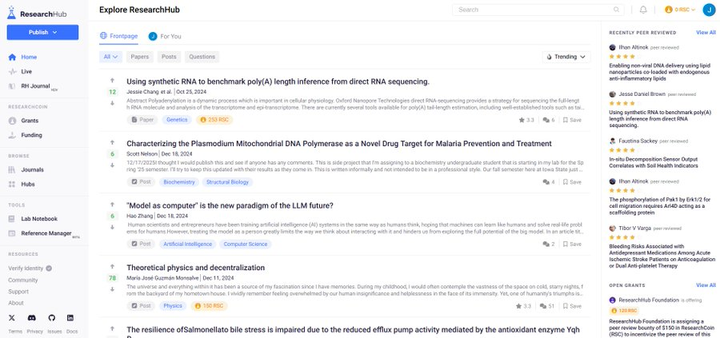
来源:ResearchHub
ResearchHub 是目前DeSci 领域的领先学术出版平台,其目标是成为**“科学界的GitHub”**。该平台由Coinbase CEO Brian Armstrong 和Patrick Joyce 创立,并在2023 年6 月完成500 万美元A 轮融资,由Open Source Software Capital 领投。
ResearchHub 提供开放的科研出版和讨论工具,并通过RSC(ResearchCoin)Token 激励研究人员发表论文、进行同行评审以及策划学术内容。
其核心功能包括:
Grants
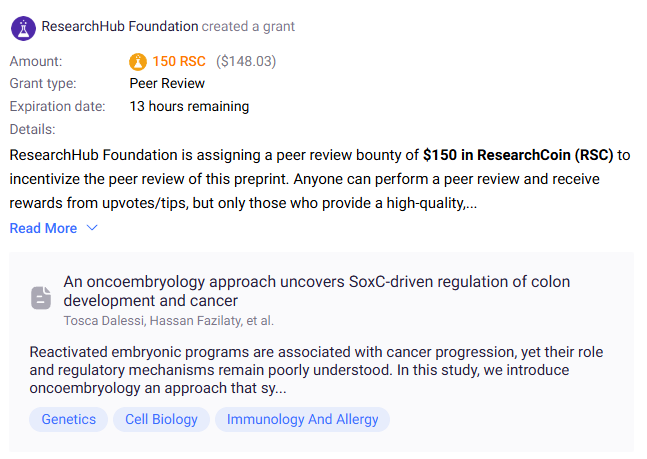
来源:ResearchHub
用户可以使用RSC Token 创建资助(Grants),向其他ResearchHub 用户请求完成特定任务。主要资助类型包括:
Peer Review: Request for review of the paper manuscript.
Answer to Question: Request answers to specific questions.
Funding for research.
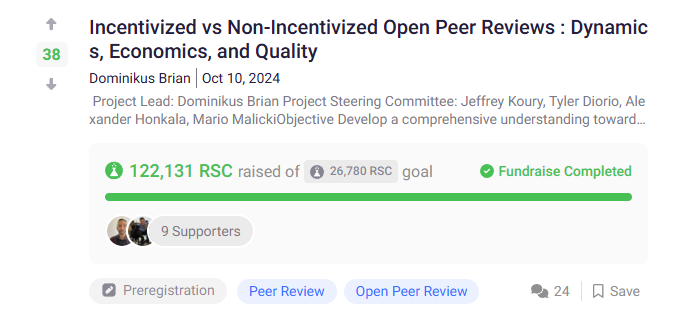
来源:ResearchHub
在Funding(资助) 选项卡中,研究人员可以上传研究提案,并从用户那里获得RSC Token资助。①. 期刊(Journals) 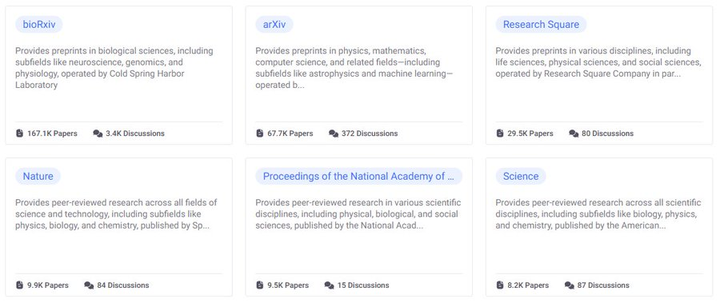
来源:ResearchHub
期刊(Journals) 部分存档了来自同行评审期刊和预印本服务器的论文。用户可以浏览学术文献并参与讨论。然而,许多同行评审论文受限于付费墙,用户通常只能查看他人撰写的摘要。
②. 研究中心(Hubs) 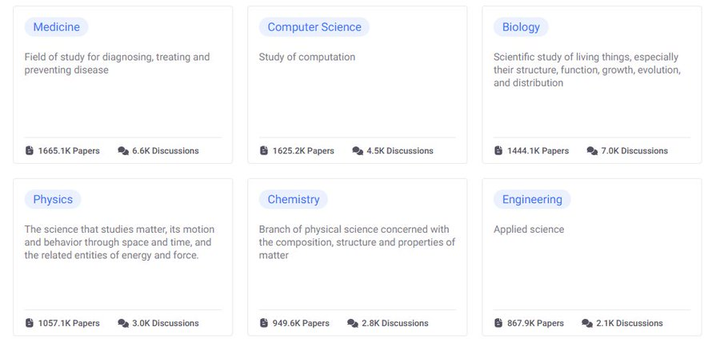
来源:ResearchHub
研究中心(Hubs) 存档了按学科分类的预印本论文。该部分所有论文均为开放获取(Open Access),任何人都可以阅读完整内容并参与讨论。
③. 实验记录本(Lab Notebook)实验记录本是一个在线协作工作区,允许多个用户共同撰写论文。类似于Google Docs 或Notion,该功能支持无缝集成至ResearchHub 并直接发布。
④. RH 期刊(RH Journal) 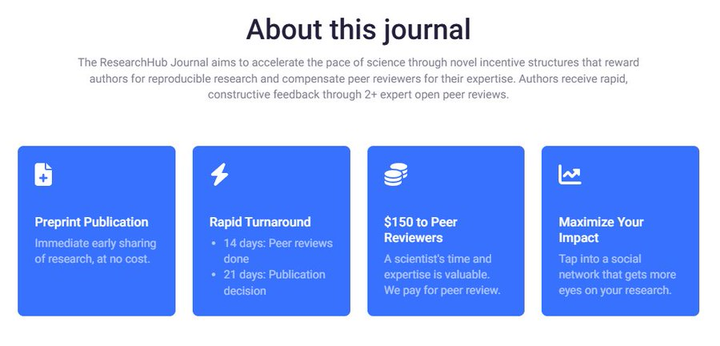
来源:ResearchHub
RH 期刊(RH Journal) 是ResearchHub 的自有学术期刊。该期刊拥有高效的同行评审流程,评审周期为14 天,最终决策在21 天内完成。此外,它还引入了同行评审激励机制,以解决传统同行评审体系中激励机制不匹配的问题。
RSCToken(RSC Token)
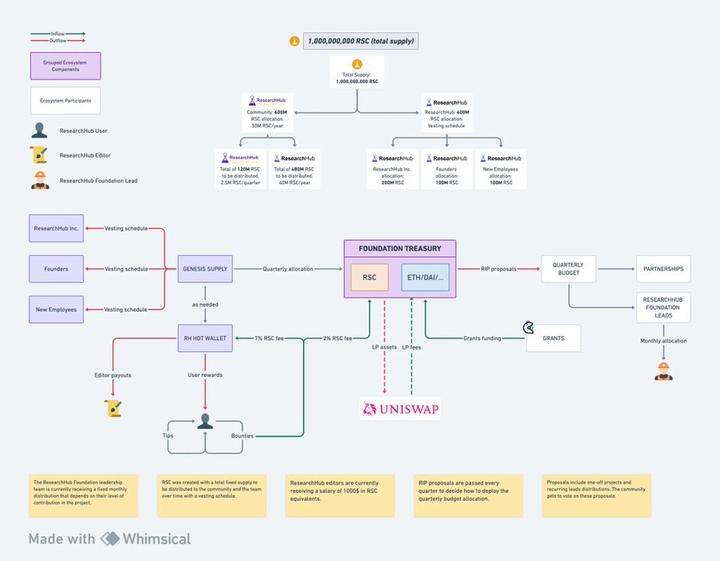
来源:ResearchHub
RSC Token(RSC Token) 是ResearchHub 生态系统中的ERC-20 Token,总供应量为10 亿。RSC Token旨在促进用户参与,并支持ResearchHub 实现完全去中心化的开放平台。
RSC Token的主要用途包括:
治理投票(Governance Voting)
打赏其他用户(Tipping Other Users)
悬赏计划(Bounty Programs)
同行评审激励(Incentives for Peer Reviewers)
研究论文策展奖励(Rewards for Curating Research Papers)
B. ScieNFT
ScieNFT 是一个去中心化预印本服务器(Decentralized Preprint Server),研究人员可以将研究成果以NFT 形式发布。其可发布内容不仅限于论文,还包括图像、研究构想、数据集、艺术作品、研究方法,甚至负面实验结果。
ScieNFT 采用去中心化存储方案,预印本数据存储在IPFS 和Filecoin 上,而NFT 资产则上传至Avalanche C-Chain。
尽管利用NFT 追踪研究成果的归属和溯源是一项优势,但ScieNFT 也存在一些问题:
购买这些NFT 的实际价值和用途尚不明确。
缺乏有效的市场策展机制,影响了内容质量管理。
C. deScier 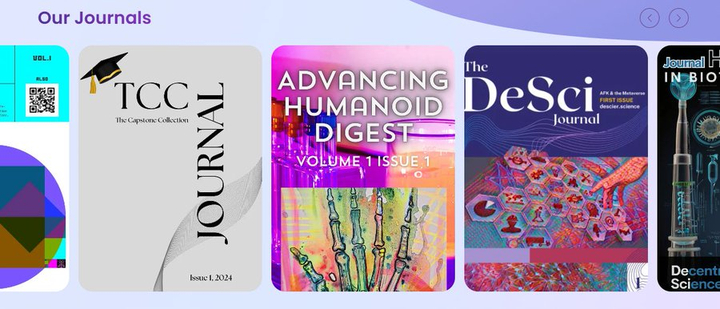
来源:deScier
D. deScier
deScier 是一个去中心化科学期刊平台。类似于Elsevier 或Springer Nature 这样的传统出版商,deScier 也托管多个期刊。
在deScier 平台上,所有论文的版权100% 归研究人员所有,并且同行评审仍是必要流程。
然而,该平台面临的主要问题是:
期刊发表论文数量较少。
论文上传速度较慢,影响了内容更新频率。
5) 数据(Data)
A. Data LakeData Lake 的软件使研究人员能够整合多种用户招募渠道,跟踪其效果,管理数据使用同意,并进行预筛选调查,同时确保用户对自身数据的控制权。
该平台允许研究人员共享并轻松管理患者数据的使用同意,以便第三方合理合规地访问数据。
Data Lake 采用Data Lake Chain,这是一个基于Arbitrum Orbit 的L3 网络,专门用于管理患者数据使用同意。
B. Welshare Health 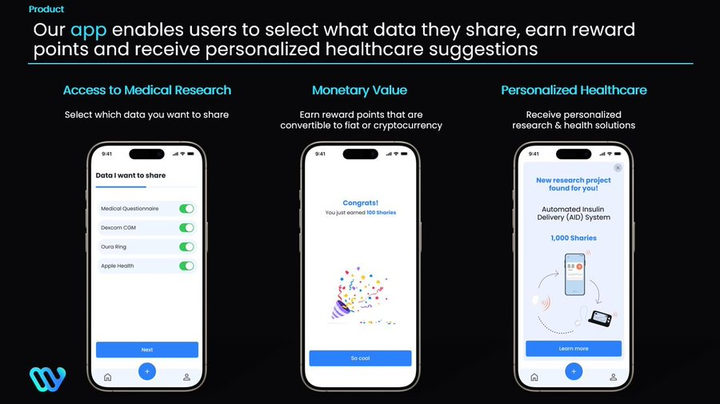
来源:Welshare Health
在传统医学研究中,最大的瓶颈之一是临床试验参与者招募缓慢以及患者数量不足。此外,患者的医疗数据虽然具有很高价值,但存在被滥用的风险。Welshare 旨在通过Web3 技术解决这些问题。
患者可以安全管理个人医疗数据,并将数据货币化以获取收入,同时获得个性化医疗服务。
医学研究人员能够更容易访问多样化的数据集,从而加速医学研究。
Welshare 通过一个基于Base Network 的应用,允许用户选择性地提供数据,以赚取应用内奖励积分,这些积分可以兑换加密货币或法币。
C. Hippocrat
Hippocrat 是一个去中心化医疗数据协议,允许个人使用区块链和零知识证明(ZKP)技术安全管理其健康数据。
其首款产品HippoDoc 是一款远程医疗应用,结合医学数据库、人工智能(AI)技术和专业医护人员支持,为患者提供医疗咨询。
在整个咨询过程中,患者数据被安全存储在区块链上,确保隐私保护和数据安全。
6)DeSci 基础设施(DeSci Infrastructure)
A. Ceramic
Ceramic 是一个去中心化事件流协议(Decentralized Event Streaming Protocol),开发者可以利用它创建去中心化数据库、分布式计算管道、身份验证数据流等功能。由于其特性,Ceramic 非常适用于DeSci 项目,使其能够作为去中心化数据库运行:
Ceramic 网络上的数据可无权限访问,研究人员可以共享和协作数据,提升科研效率。
研究论文、引用和评审等操作在Ceramic 网络上被表示为“Ceramic 流”(Ceramic Streams),每个流只能由其创建者账户修改,从而确保知识产权(IP)溯源。
Ceramic 还提供可验证声明(Verifiable Claims)基础设施,允许DeSci 项目采用其信誉管理系统,增强科研信任机制。
B. bloXberg
bloXberg 是一个科研专用区块链基础设施,由德国马克斯·普朗克数字图书馆(Max Planck Digital Library) 牵头建立,合作机构包括瑞士苏黎世联邦理工学院(ETH Zurich)、慕尼黑大学(Ludwig Maximilian University of Munich)、哥本哈根IT 大学(IT University of Copenhagen) 等知名研究机构。
bloXberg 旨在推动科学研究流程的创新,其应用领域包括:
研究数据管理
同行评审(Peer Review)
知识产权保护
通过区块链技术去中心化这些流程,bloXberg 提升了科研的透明度和效率。研究人员可以安全地共享和协作科研数据,确保数据的可信性和不可篡改性。
6、DeSci 真的是万能解药吗?
我们已经探讨了现代科学体系的结构性问题,以及DeSci 如何尝试解决这些问题。但问题是——DeSci 真的能如加密社区所宣称的那样,彻底颠覆科学界并成为核心力量吗?
I don't think so.然而,DeSci 确实有潜力在特定领域发挥辅助作用。
1)区块链能解决什么,不能解决什么
区块链不是魔法,它无法解决所有问题。因此,我们需要清楚地区分区块链可以解决和无法解决的问题。A. 科研资助(Funding)DeSci 在以下几种资助场景中具备优势:
小规模研究资助(Small-scale grants)
具有商业化潜力的研究(Research with commercialization potential)
科研资



 jinse
jinse